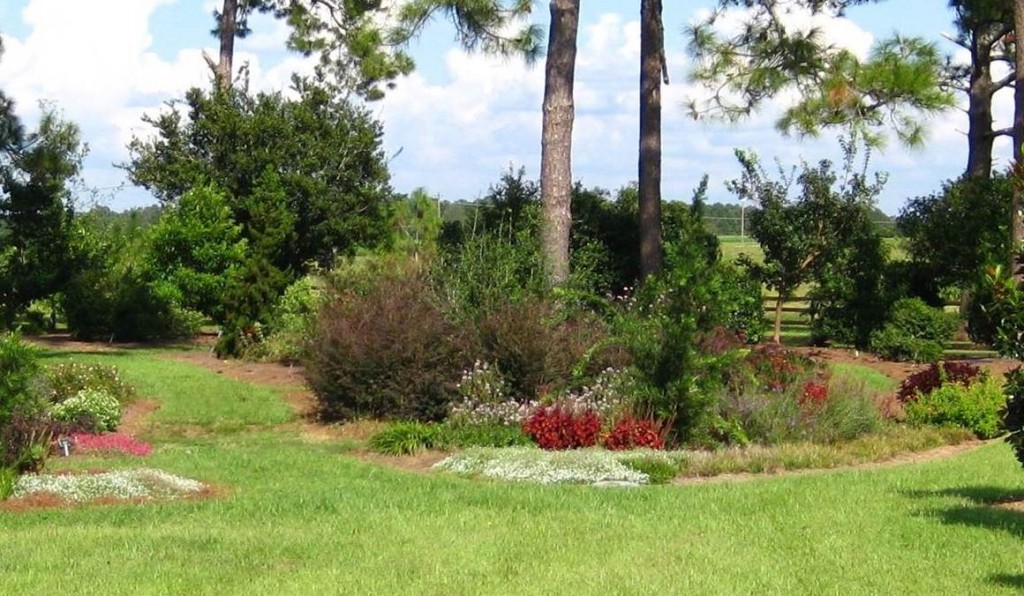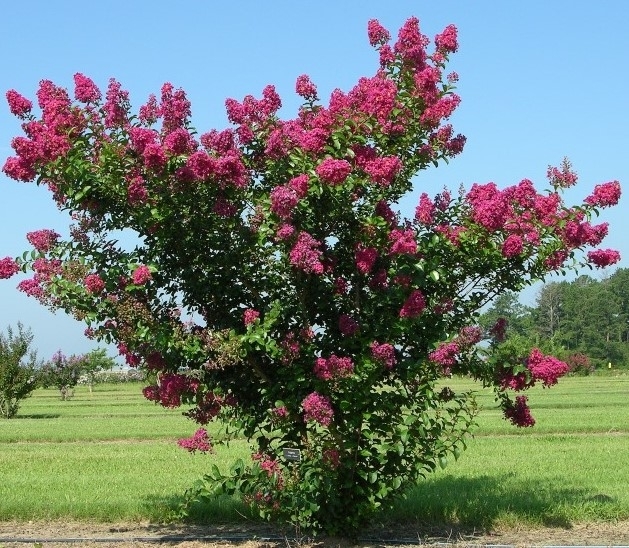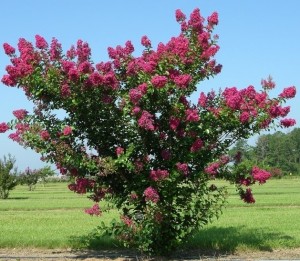
Crapemyrtle Research and Disease Management Update: Thursday,October 31; FL Pesticide and FNGLA CEUs available


The Discovery Garden, showcasing new plants, in Gardens of the Big Bend at UF/IFAS North Florida Research and Education Center, Quincy.
The University of Florida Institute of Food and Agricultural Sciences presents “Art & Garden,” Saturday October 5, at the North Florida Research and Education Center (NFREC) in Quincy. The free event will highlight creative ways to explore visual art and the art of gardening.
Spend the day learning, discovering and engaging in fun activities for the whole family. Learn about floral arranging, container gardens, native plants that attract wildlife, and combating pests and invasive plants in your garden. Join a walking tour of the Gardens or take a trolley tour to view cold-hardy citrus and deciduous fruit. Watch plein-air artists painting on-site throughout the garden. Discover how to make mosaic stepping stones as well as birdbaths from large leaves. Children can spend the day painting pumpkins, planting sweet potato sprouts to take home, or painting, drawing, and making birdfeeders with staff and volunteers from the Gadsden Arts Center.
An exciting array of trees, shrubs, flowers, organic produce and arts and crafts will be for sale. NFREC staff will be offering free soil testing and a plant disease clinic, so bring a sample of your soil or a clipping of a plant problem from your home garden. The day-long, family-friendly event is free and open to the public.
Plant, produce and art sales by vendors
Wendy Adams, Havana Garden Club
Garden Pavilion
Dr. Pete Andersen and Dr. Russ Mizell
Kay Edwards, Quincy Garden Club
Garden Pavilion
Dr. Katerie Gladdys, University of Florida School of Art
Exhibit Hall
~ First Silent Auction ends ~
Cathy Boatright, Havana Garden Club
Garden Pavilion
Dr. Josh Freeman
Dr. Gary Knox
Garden Pavilion
By Dawn McMillan and Gary Knox
Is the newest growth on your sago palm turning yellow, brown, frizzy looking and dying – is it a pest or disease or something else?
This sago palm is suffering from a classic case of manganese deficiency. When sago palms lack manganese, the newest leaves will develop yellow splotches or be entirely yellow. As the leaves die, they turn brown and take on a frizzled appearance. Sometimes the leaves or fruit may be smaller than normal. If left unchecked, the sago usually dies.
Manganese is a micronutrient required by all plants for normal, healthy growth and is most available for plant uptake when the soil pH is between 5.5 and 6.5. Soils in the Florida panhandle are often naturally low in manganese and then what available manganese is present can be unavailable for the plant to use if the pH of the soil is much above 6.5. Also, manganese tends to be leached from the soil when the pH is below 5.5. Soil pH and nutrient testing is useful to determine if soils are nutrient deficient. Contact your county Extension office for information on getting that done.
[notice]Before treating, rule out an infestation of Asian cycad scale. Click here for a UF IFAS Extension publication on this damaging insect. Be aware that both are common problems for sago palms and that your sago may be afflicted with both![/notice]
If this is happening to a sago palm, the good news is that it is easy to correct. Manganese sulfate is readily available at garden centers, feed &seed stores and independent nurseries. Just make sure to get manganese sulfate and don’t confuse it with magnesium sulfate (Epson salts). The amount of manganese sulfate necessary to correct this deficiency will vary with its size, soil type and pH. Sago palms in sandy, acidic soils require less manganese sulfate than those in high pH soils. One ounce is sufficient for a very small plant in sandy, acidic soil. A very large sago in a high pH soil may require about five pounds, however. Spread the product evenly over the root zone and water in with about a half inch of water.
The affected leaves cannot be cured but new growth should return to normal. If the new growth is still affected, an additional application of manganese sulfate may be needed. Once sago palms have suffered from a manganese deficiency, half the initial rate should be applied yearly to prevent the deficiency from re-occurring.
Even though sago palms are not true palms – they are cycads – their nutritional needs are very similar to palms. Most of the time they grow well without any supplemental fertilization, but if they do need fertilizing, use a 8-2-12-4 (the fourth number is magnesium) palm fertilizer with micronutrients and avoid using other fertilizer products in their root zones.
For more information on sago palms please see:

Azaleas pruned late in the fall will have little or no bloom in the spring. Image Credit: Matthew Orwat
Pruning Azaleas in the fall will result in a loss of spring bloom the following year because most bloom on previous years’ wood. This means that they flower on growth put on throughout the previous growing season. If a gardener removes the previous season’s new growth, they are removing the blooms as well.
So, when is the proper time to prune Azaleas? The ideal time to prune is directly after the spring bloom. This will give the plant enough time to generate abundant new growth, thus maximizing bloom next spring.
For more information on pruning Azaleas or on general Azalea culture, please read the UF / IFAS publication Azaleas at a Glance or check out the Pruning Azalea page on Gardening in a Minute.
This summer’s rainy and humid weather has created a perfect environment for the proliferation of a variety of fungal diseases. In particular, Cercospora is a genus of fungus of which there are over 1,200 different species. Because there are so many species of this fungus, many different plant species are affected including many garden vegetables and ornamentals.
Cercospora causes purple, brown or black spots on a variety of garden vegetables and ornamental shrubs. The spots usually include a grey dead area in the center and a yellow “halo” or “ring” surrounding the entire spot. This disease usually starts at the base and interior of the plant, where there is more moisture and less air circulation, and moves outward.
Severe Cercospora infections have the ability to defoliate entire plants within a season and kill garden annuals, such as pepper, within a season. On shrubs, turf and perennials, Cercospora ranges from minor annoyance to major disease depending on the resistance of the cultivar or species. Serious infections can kill some ornamentals, such as Indian Hawthorn or Rose, in three years.
Several methods exist to limit the spread and severity of Cercospora outbreaks. It is a good practice to remove all dead plants and leaf litter from the garden. If Cercosproa infection occurs, remove and dispose of dead plants and pick up all leaf litter from the garden immediately upon drop. This will limit the fungal spore’s ability to reproduce. Another preventative strategy is to reduce water splash on leaves. Splashing water spreads Cercospora spores and allows them to take hold on a leaf. Irrigate the vegetable garden or landscape with drip irrigation to avoid wet leaves. Additionally, irrigate in the morning, so plants will not remain wet overnight. Cercospora requires 16 hours of moisture to reproduce. Specifically, infection of Indian Hawthorn has proven to be reduced by switching from overhead to drip irrigation.
If fungicides must be used, be sure to follow label directions since some products labeled for the home ornamental garden, such as Chlorothalonil, are not labeled for turf. Be sure to use fungicides with more than one mode of action, since resistance may develop if only one type of fungicide is used.
Also, contact your County Extension Office for additional assistance.


Crapemyrtle Cultivar: ‘Tonto’
Image Credit: Gary Knox
Just say “No” to Pruning
Tree-size crapemyrtles grow 25 ft. tall and are ideal as flowering trees. Patio tree-form plants (up to 12 ft.) are beautiful as small, flowering specimen plants near patios, walkways, and entrances. Shrub forms (up to 6 ft.) make excellent accents in a shrub border and smaller types are effective as large groundcovers or container plants.
Recommended Varieties
Planting and Garden Care
More Beauty on the Way!
*Gary Knox is Professor of Environmental Horticulture with the University of Florida. He is stationed at the North Florida Research and Education Center in Quincy, where he evaluates more than 100 cultivars of crapemyrtle.